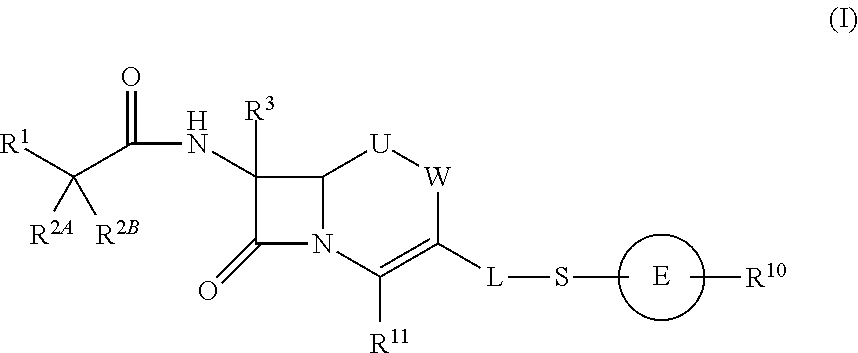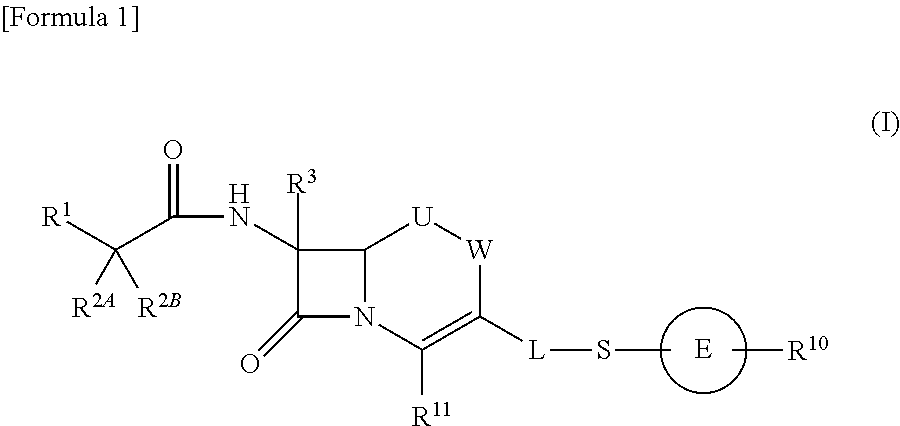Cephem compound having pyridinium group
- Summary
- Abstract
- Description
- Claims
- Application Information
AI Technical Summary
Benefits of technology
Problems solved by technology
Method used
Image
Examples
example 1
Compound I-1
[0242]Compound 1h+Compound 1i→Compound I-1
[0243]To a solution of Compound 1i (200 mg) / DMF (1.5 ml) was added BSA (0.16 ml), and the mixture was stirred at room temperature for 10 minutes. To this solution were added Compound 1h (200 mg) and NaBr (90 mg), and the mixture was stirred at room temperature for 4 hours. To the mixture was added 2 mol / l hydrochloric acid (0.5 ml), and the mixture was stirred for 5 minutes. The mixture was poured into aqueous sodium chloride solution, and the resulting precipitates were collected by filtration, dissolved in methylene chloride, washed with water, dried and concentrated. The residue was dissolved in methylene chloride (5 ml), and thereto were added anisole (0.25 ml) and TFA (2 ml), and the mixture was stirred at room temperature for 1.5 hour. The resultant was treated in a conventional manner, and purified by HP-20 chromatography, and lyophilized to give Compound I-1 (92 mg).
[0244]1H-NMR (d6-DMSO) δ: 1.43 (3H, s), 1.46 (3H, s), 3....
example 2
Compound I-2
[0247]Compound 1h+Compound 2a→Compound I-2
[0248]To a solution of Compound 1h (250 mg) in DMF (2 ml) were added Compound 2a (165 mg) and NaBr (110 mg), and the mixture was stirred at room temperature for 2 hours, and then stirred at 8° C. for 15 hours. The mixture was poured into an aqueous sodium chloride solution, and the resulting precipitates were collected by filtration, dissolved in methylene chloride, washed with water, and concentrated to give a residue (0.40 g). The obtained residue was dissolved in methylene chloride (5 ml), and thereto was added anisole (0.65 ml), and further added TFA (4 ml), and the mixture was stirred at room temperature for 1.5 hour. The resultant was treated in a conventional manner, purified by HP-20 column chromatography, and lyophilized to give Compound I-2 (99 mg).
[0249]1H-NMR (d6-DMSO) δ: 1.20 (3H, s), 1.34 (3H, s), 3.33, 3.52 (2H, AB-q, J=16.5 Hz), 4.16, 4.46 (2H, AB-q, J=12.9 Hz), 5.09 (1H, d, J=5.1 Hz), 5.52-5.56 (1H, m), 5.83 (2H,...
example 3
Compound I-3
[0252]Compound 1h+Compound 3a→Compound I-3
[0253]To a suspension of Compound 3a (380 mg) / methylene chloride (10 ml) was added triethylamine (154 μl). Under ice-cooling, methanesulfonyl chloride (84 μl) was added thereto, and the mixture was stirred under ice-cooling for 40 minutes, and further stirred at room temperature for 30 minutes. To this reaction solution were added a solution of Compound 1h (300 mg) / DMF (4 ml) and NaI (450 mg), and the mixture was stirred at room temperature for 2 hours, and then stirred at 40° C. for 2 hours. The mixture was poured into an aqueous sodium chloride solution, and the resulting precipitates were collected by filtration, dissolved in methylene chloride, washed with water, dried and concentrated. The residue was dissolved in methylene chloride (10 ml), and thereto were added anisole (0.8 ml) and TFA (6 ml), and the mixture was stirred at room temperature for 2 hours, and allowed to stand at 8° C. for 15 hours. The mixture was treated i...
PUM
 Login to View More
Login to View More Abstract
Description
Claims
Application Information
 Login to View More
Login to View More - R&D
- Intellectual Property
- Life Sciences
- Materials
- Tech Scout
- Unparalleled Data Quality
- Higher Quality Content
- 60% Fewer Hallucinations
Browse by: Latest US Patents, China's latest patents, Technical Efficacy Thesaurus, Application Domain, Technology Topic, Popular Technical Reports.
© 2025 PatSnap. All rights reserved.Legal|Privacy policy|Modern Slavery Act Transparency Statement|Sitemap|About US| Contact US: help@patsnap.com



